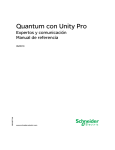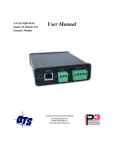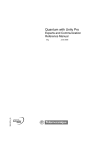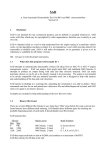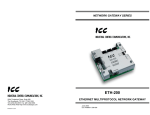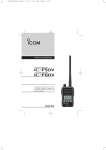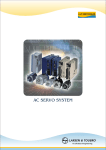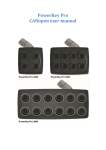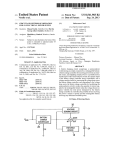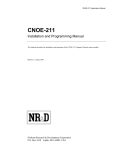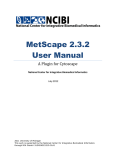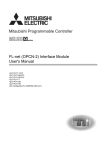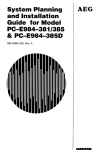Download RIO Adapter Module - Schneider Electric
Transcript
Instruction Bulletin 30598-822-01A1 August 1996 RIO Adapter Module Class 8030 Type CRM931 User’s Manual WARNING UNINTENTIONAL EQUIPMENT OPERATION The application of this product requires expertise in the design and programming of control systems. Only persons with such expertise should be allowed to program, install, alter, or apply this product. Failure to observe this precaution can result in death or serious injury. CAUTION EQUIPMENT DAMAGE HAZARD To avoid improper handling of equipment: 1. Never remove this device while power is ON. Turn power supply switch to OFF and wait until all indicating lights are off before removing. 2. Do not subject to static discharge. This module contains electronic components that are very susceptible to damage from electrostatic discharge. Failure to observe this precaution can result in equipment damage. SY/MAX is a registered trademark of Square D. Modbus and Modsoft are registered trademarks of Modicon, Inc. © 1996 Square D All Rights Reserved. This document may not be copied in whole or in part, or transferred to any other media without the written permission of Square D. Electrical equipment should be serviced only by qualified electrical maintenance personnel. No responsibility is assumed by Square D for any consequences arising out of the use of this material. 30598-822-01A1 Page i TABLE OF CONTENTS TABLE OF CONTENTS . . . . . . . . . . . . . . . . . . . . . . . . . . . . . . . . . . . . . . . . . . . . . . . . . . . . . . . . . . . . . . i LIST OF FIGURES AND TABLES . . . . . . . . . . . . . . . . . . . . . . . . . . . . . . . . . . . . . . . . . . . . . . . . . . . . . ii 1 OVERVIEW . . . . . . . . . . . . . . . . . . . . . . . . . . . . . . . . . . . . . . . . . . . . . . . . . . . . . . . . . . . . . . . . . . . . 1 1.1 GENERAL INFORMATION . . . . . . . . . . . . . . . . . . . . . . . . . . . . . . . . . . . . . . . . . . . . . . . . . . . . . . . . 1 1.2 RIO DROP MODULE FEATURES . . . . . . . . . . . . . . . . . . . . . . . . . . . . . . . . . . . . . . . . . . . . . . . . . . 2 1.3 WHERE TO FIND ADDITIONAL INFORMATION . . . . . . . . . . . . . . . . . . . . . . . . . . . . . . . . . . . . . . . 2 1.4 TERMINOLOGY USED IN THIS MANUAL . . . . . . . . . . . . . . . . . . . . . . . . . . . . . . . . . . . . . . . . . . . . 2 2 SPECIFICATIONS . . . . . . . . . . . . . . . . . . . . . . . . . . . . . . . . . . . . . . . . . . . . . . . . . . . . . . . . . . . . . . 5 2.1 COMPLIANCE INFORMATION . . . . . . . . . . . . . . . . . . . . . . . . . . . . . . . . . . . . . . . . . . . . . . . . . . . . 5 2.2 ELECTRICAL SPECIFICATIONS . . . . . . . . . . . . . . . . . . . . . . . . . . . . . . . . . . . . . . . . . . . . . . . . . . . 5 2.3 ENVIRONMENTAL SPECIFICATIONS . . . . . . . . . . . . . . . . . . . . . . . . . . . . . . . . . . . . . . . . . . . . . . 5 2.4 PHYSICAL SPECIFICATIONS . . . . . . . . . . . . . . . . . . . . . . . . . . . . . . . . . . . . . . . . . . . . . . . . . . . . . 5 2.5 FUNCTIONAL SPECIFICATIONS . . . . . . . . . . . . . . . . . . . . . . . . . . . . . . . . . . . . . . . . . . . . . . . . . . 2.5.1 Register Capabilities . . . . . . . . . . . . . . . . . . . . . . . . . . . . . . . . . . . . . . . . . . . . . . . . . . . . . . . 2.5.2 Communications Capabilities . . . . . . . . . . . . . . . . . . . . . . . . . . . . . . . . . . . . . . . . . . . . . . . . . 2.5.3 Supported Processor Types . . . . . . . . . . . . . . . . . . . . . . . . . . . . . . . . . . . . . . . . . . . . . . . . . . 2.5.4 Compatibility with SY/MAX Racks . . . . . . . . . . . . . . . . . . . . . . . . . . . . . . . . . . . . . . . . . . . . . 5 5 6 6 6 2.6 RESPONSE TIMES . . . . . . . . . . . . . . . . . . . . . . . . . . . . . . . . . . . . . . . . . . . . . . . . . . . . . . . . . . . . . 7 3 INSTALLATION . . . . . . . . . . . . . . . . . . . . . . . . . . . . . . . . . . . . . . . . . . . . . . . . . . . . . . . . . . . . . . . . 9 3.1 GENERAL INFORMATION . . . . . . . . . . . . . . . . . . . . . . . . . . . . . . . . . . . . . . . . . . . . . . . . . . . . . . . . 9 3.2 KEYING THE RACK . . . . . . . . . . . . . . . . . . . . . . . . . . . . . . . . . . . . . . . . . . . . . . . . . . . . . . . . . . . . . 9 3.3 SETTING MODULE SWITCHES . . . . . . . . . . . . . . . . . . . . . . . . . . . . . . . . . . . . . . . . . . . . . . . . . . 10 3.4 INSTALLING THE MODULE . . . . . . . . . . . . . . . . . . . . . . . . . . . . . . . . . . . . . . . . . . . . . . . . . . . . . . 10 3.5 WIRING THE CRM931 FOR THE RIO NETWORK . . . . . . . . . . . . . . . . . . . . . . . . . . . . . . . . . . . . 10 3.6 POWERING UP THE RIO ADAPTER MODULE . . . . . . . . . . . . . . . . . . . . . . . . . . . . . . . . . . . . . . 11 3.7 RIO DROP HARDWARE START-UP CHECKLIST . . . . . . . . . . . . . . . . . . . . . . . . . . . . . . . . . . . . 11 4 OPERATION . . . . . . . . . . . . . . . . . . . . . . . . . . . . . . . . . . . . . . . . . . . . . . . . . . . . . . . . . . . . . . . . . . 13 4.1 GENERAL INFORMATION . . . . . . . . . . . . . . . . . . . . . . . . . . . . . . . . . . . . . . . . . . . . . . . . . . . . . . . 13 4.2 RIO DROP REGISTERS . . . . . . . . . . . . . . . . . . . . . . . . . . . . . . . . . . . . . . . . . . . . . . . . . . . . . . . . . 13 4.3 REMOTE I/O BEHAVIOR . . . . . . . . . . . . . . . . . . . . . . . . . . . . . . . . . . . . . . . . . . . . . . . . . . . . . . . . 13 4.4 RACK ADDRESSING . . . . . . . . . . . . . . . . . . . . . . . . . . . . . . . . . . . . . . . . . . . . . . . . . . . . . . . . . . . 14 4.5 USING A MODICON PLC WITH A SY/MAX I/O MODULE . . . . . . . . . . . . . . . . . . . . . . . . . . . . . . . 15 4.5.1 SY/MAX Register I/O Modules . . . . . . . . . . . . . . . . . . . . . . . . . . . . . . . . . . . . . . . . . . . . . . . 16 4.5.2 SY/MAX Digital I/O Modules . . . . . . . . . . . . . . . . . . . . . . . . . . . . . . . . . . . . . . . . . . . . . . . . 16 5 TROUBLESHOOTING . . . . . . . . . . . . . . . . . . . . . . . . . . . . . . . . . . . . . . . . . . . . . . . . . . . . . . . . . . 19 5.1 GENERAL INFORMATION . . . . . . . . . . . . . . . . . . . . . . . . . . . . . . . . . . . . . . . . . . . . . . . . . . . . . . . 19 5.2 PROGRAMMING EQUIPMENT . . . . . . . . . . . . . . . . . . . . . . . . . . . . . . . . . . . . . . . . . . . . . . . . . . . 20 5.3 UNDERVOLTAGE LOCKOUT CIRCUIT (ULC) OPERATION . . . . . . . . . . . . . . . . . . . . . . . . . . . . 21 Table of Contents Page ii 30598-822-01A1 LIST OF FIGURES AND TABLES Figure 1 Figure 2 Figure 3 CRM931 RIO Adapter Module Front Panel Features . . . . . . . . . . . . . . . . . . . . . . . . . . . 3 CRM931 Dimensions . . . . . . . . . . . . . . . . . . . . . . . . . . . . . . . . . . . . . . . . . . . . . . . . . . . . 5 Keying the Rack . . . . . . . . . . . . . . . . . . . . . . . . . . . . . . . . . . . . . . . . . . . . . . . . . . . . . . . . 9 Table 1: Table 2: Table 3: Table 4: Table 5: Table 6: Table 7: Table 8: Table 9: Table 10: Table 11: Table 12: Table 13: Table 14: Table 15: Equivalent Terms . . . . . . . . . . . . . . . . . . . . . . . . . . . . . . . . . . . . . . . . . . . . . . . . . . . . . . . 2 RIO Processors With RIO Capabilities . . . . . . . . . . . . . . . . . . . . . . . . . . . . . . . . . . . . . . 6 Response Times . . . . . . . . . . . . . . . . . . . . . . . . . . . . . . . . . . . . . . . . . . . . . . . . . . . . . . . 7 RIO Drop Switches . . . . . . . . . . . . . . . . . . . . . . . . . . . . . . . . . . . . . . . . . . . . . . . . . . . . 10 CRM931 Modicon Module IDs . . . . . . . . . . . . . . . . . . . . . . . . . . . . . . . . . . . . . . . . . . . . 14 Sample Hardware Configuration . . . . . . . . . . . . . . . . . . . . . . . . . . . . . . . . . . . . . . . . . . 14 System Addressing . . . . . . . . . . . . . . . . . . . . . . . . . . . . . . . . . . . . . . . . . . . . . . . . . . . . 14 Bit Reversal . . . . . . . . . . . . . . . . . . . . . . . . . . . . . . . . . . . . . . . . . . . . . . . . . . . . . . . . . . 15 Mapping for SY/MAX I/O Modules in a Register Rack . . . . . . . . . . . . . . . . . . . . . . . . . . 16 Mapping for SY/MAX I/O Modules in a Digital Rack . . . . . . . . . . . . . . . . . . . . . . . . . . . 16 Mapping for SY/MAX Digital I/O Modules . . . . . . . . . . . . . . . . . . . . . . . . . . . . . . . . . . . 16 SY/MAX Register I/O Modules . . . . . . . . . . . . . . . . . . . . . . . . . . . . . . . . . . . . . . . . . . . . 17 SY/MAX Digital I/O Modules . . . . . . . . . . . . . . . . . . . . . . . . . . . . . . . . . . . . . . . . . . . . . 18 LED Indicators and Descriptions for the RIO Drop Module . . . . . . . . . . . . . . . . . . . . . . 19 System Conditions and Corresponding RIO Drop LED States . . . . . . . . . . . . . . . . . . . 20 List of Figures and Tables 30598-822-01A1 1 Page 1 OVERVIEW 1.1 GENERAL INFORMATION The Class 8030 Type CRM931 RIO adapter module provides a communication interface between a Quantum processor and remote SY/MAX® I/O on the RIO network. This interface provides the means for the processor to read and write to the input and output signals of SY/MAX Class 8030 rack-mounted I/O. The RIO adapter module resides in register slot 1 of the remote SY/MAX Class 8030 Type RRK100, 200, or 300 register rack and Class 8030 Type HRK100, 150, or 200 digital rack assemblies and allows control of SY/MAX Class 8030 discrete and intelligent I/O by a Quantum processor. Information exchanged between the RIO adapter module and the RIO head includes register data, I/O module identification, and bus status. Modicon’s RIO network is a high-speed (1.544 Mb/s) local area network (LAN) which uses commercially available coaxial cable and CATV media technology. PLC communicators service their drop adapters only at the end of logic segments. Multiple logic segments may be serviced in one scan. Updating RIO drop data at the end of a segment ensures consistent data throughout the segment. A CRC16 message frame check assures that RIO drop messages will arrive at the proper destination node. As a high-speed LAN, RIO drops must support applications that are time critical. With respect to speed, RIO has several advantages over other proprietary PLC communication methods: • RIO data transfer speed is predictable because of HDLC protocol implementation. • Message collisions do not occur because only one node transmits at a given time. • Each drop has high data integrity due to the frame check sequence and error checking at the physical protocol layer. The RIO network supports communications between a PLC and one or more drops of I/O modules that are dispersed throughout a local area—e.g., a manufacturing or processing facility. The RIO head or processor, a master node, initiates all messages on the RIO network. All other nodes on the network communicate with the RIO head via RIO adapter modules located at the drops. The CRM931 RIO adapter module is compatible with a Modicon Quantum or E984-785 Programmable Logic Controller (PLC) when inserted in a remote SY/MAX Class 8030 Type HRK or Type RRK rack. The remote rack must be part of a Modicon S908 RIO system. Modicon Modsoft Software, Revision 2.31 or later, is required to use the CRM931 RIO adapter module. Contact a Square D distributor for upgrade information. Chapter 1 - Overview Page 2 30598-822-01A1 1.2 RIO DROP MODULE FEATURES Figure 1 on page 3 shows the CRM931 RIO adapter module. The module offers the following features: • User-selectable rotary switches identify the RIO drop module as one of up to 31 drops per RIO head. See Table 4 on page 10. • 128 addressable registers [64 input and 64 output] are available per RIO drop. • Four LEDs indicate status of the RIO adapter module. See “GENERAL INFORMATION” on page 19. • Data transfer rate equals 1.544 Mb/s. • One “F” type female connector with a right angle adapter provides one-channel external communication. • Continuous I/O updates information even when power or communication is lost to one or more additional drops. 1.3 WHERE TO FIND ADDITIONAL INFORMATION The following documents contain information regarding cabling and installation: • Modicon Remote I/O (#890 USE 101 00) Cable System Planning and Installation Guide • Modicon Modsoft Programmer User Manual (#890 USE 105 00) Note: This system is not compatible with I/O Network Passport Systems. 1.4 TERMINOLOGY USED IN THIS MANUAL Table 1 lists some common terms for Square D automation products and the terms for similar Modicon products. Table 1: Equivalent Terms Chapter 1 - Overview Square D Modicon LI (Local Interface) RIO Head RI (Remote Interface) RIO Adapter Module LI/RI System RIO Network Remote Racks RIO Drops Halt Stopped Rack Addressing I/O Mapping 30598-822-01A1 Page 3 SY/MAX ® CLASS 8030 TYPE CRM931 READY COMM ACTIVE COMM ERROR LOCAL RACK ERROR WARNING UNINTENDED OPERATION Bits may be swapped on I/O information to processor. Refer to bulletin 30598822-01 prior to address use or change. Failure to observe can cause death, serious injury, or equipment damage. CHANNEL A REMOTE I/O ADAPTER Figure 1 CRM931 RIO Adapter Module Front Panel Features Chapter 1 - Overview Page 4 30598-822-01A1 Notes: Chapter 1 - Overview 30598-822-01A1 2 Page 5 SPECIFICATIONS 2.1 COMPLIANCE INFORMATION The CRM931 RIO adapter module complies with requirements of UL 508, CSA C22-2, and Factory Mutual Class 1 Division 2 Hazardous Locations. 2.2 ELECTRICAL SPECIFICATIONS Current Draw on SY/MAX Power Supply: Class 8030 Type CRM931 750 mA (typical); 900 mA (maximum) Undervoltage Lockout Circuit Halts and resets the CRM931 RIO adapter module and removes it from the RIO network when the incoming DC supply voltage falls below approximately 4.6 VDC. 2.3 ENVIRONMENTAL SPECIFICATIONS Ambient Temperature: Operational Storage 32 to 140° F (0 to 60° C) -13 to 176° F (-25 to 80° C) Humidity: 5 - 95%, non-condensing 2.4 PHYSICAL SPECIFICATIONS 1.5" 6.6" SY/MAX Dimensions: CLASS 8030 TYPE CRM931 Width: 1.5” (3.8 cm) 5.1" Height: 12.1” (30.7 cm) 9.6" Depth: 6.6” (16.8 cm) 2.5 FUNCTIONAL SPECIFICATIONS 2.5.1 Register Capabilities 12.1" 2.8 pounds (1.27 kg) 1" Weight: .75" .75" The CRM931 has a maximum of 128 (64 input and 64 output) registers available for external I/O addressing. REMOTE I/O ADAPTER Front View Side View Figure 2 CRM931 Dimensions Chapter 2 - Specifications Page 6 30598-822-01A1 2.5.2 Communications Capabilities Method Half-duplex, NRZI-encoded synchronous, with the RIO head acting as the polling master. Transmission rate 1.544 Mb/s. Message packet integrity ensured with a 16-bit CRC; other flagged error conditions include message time-outs (no reply), collisions, and improper replies. Isolation 500 VDC, transformer coupled. Distance 4,000 feet/1,200 meters maximum. 2.5.3 Supported Processor Types Table 2: RIO Processors With RIO Capabilities PLC Type Hardware Dynamic Range 984A 984B 984X AT-984 MC-984 Q-984 984-485E/K 984-685E Maximum RIO Drops Not Supported S908 slot mount module with AS-Q908-016 Executive 984-785E/K/D 32 dB 15 32 dB 31 E785 with SW-E785-Q00 Executive 140 CPU 113 02 140 CPU 113 03 140 CRP 931 or 140 CRP 932 Quantum module 140 CPU 213 04 2.5.4 Compatibility with SY/MAX Racks The CRM931 module operates only in register slot 1 of these rack model numbers: Class 8030 Type RRK-100, RRK-200, and RRK-300 Class 8030 Type HRK-100, HRK-150, and HRK-200 CAUTION UNINTENDED EQUIPMENT ACTION Using any rack other than Class 8030 Type RRK-100, RRK-200, and RRK-300 or Class 8030 Type HRK-100, HRK-150, and HRK-200 can cause erratic operation. Failure to observe this instruction can result in injury or equipment damage. Chapter 2 - Specifications 30598-822-01A1 Page 7 Physically place one and only one RIO head, or network manager, into the Modicon processor rack. Refer to Modicon Remote I/O Cable-System Planning and Installation Guide (890 USE 101 00) for information on Modicon installation requirements. All CRM931 modules on the RIO network must be in slot 1 of their respective remote drops. Each CRM931 module that acts as a remote interface, or network subscriber, must be connected to the RIO network and uniquely addressed. Refer to Modicon Remote I/O Cable-System Planning and Installation Guide (890 USE 101 00) for information on Modicon installation requirements. All CRM931 modules on the RIO network must have a drop setting. Wiring for “end of the wire” CRM931 modules must have transmission line termination. Other configuration setup parameters are set during rack addressing in the programming environment. 2.6 RESPONSE TIMES Product response times vary according to the system configuration used. Table 3 lists typical response times that correspond to a configuration of DC input and DC output and a one-line program with one input and one output rung. Table 3: Response Times Type of System Response Time * SY/MAX (LI/RI) 8.2 - 18.2 ms All Quantum 1.8 - 14.8 ms Quantum Processor with SY/MAX remote rack 1.7 - 14.7 ms * Due to the varied and integral nature of PLC system set-ups, the response times should be used only as a guide. Differences in scan times produce variance. Chapter 2 - Specifications Page 8 30598-822-01A1 Notes: Chapter 2 - Specifications 30598-822-01A1 3 Page 9 INSTALLATION 3.1 GENERAL INFORMATION CAUTION EQUIPMENT DAMAGE HAZARD To prevent possible equipment damage, remove power from local or remote racks before inserting or removing any component, including interface modules and communication cable. Failure to observe this instruction can result in injury or equipment damage. The RIO system allows Quantum or E984-785 PLCs to control inputs and outputs that are not installed in the same rack as the processor. The RIO adapter module applies the ladder logic decisions of the processor corresponding to the range of output addresses under the RIO adapter module’s control. Through the RIO head, the RIO adapter module then reports the states of the inputs back to the processor. The RIO adapter module implements control of both decisions based on the operating state of the processor and the state of associated outputs (when the processor halts). Special control bit options also allow the RIO adapter module to maintain the last state of the outputs (FREEZE) or assume a pre-determined value in the event of a transmission failure. 3.2 KEYING THE RACK To prevent modules from being put in different slots than the ones for which they were originally configured, each register slot should be keyed. An optional keying pin kit, Class 8030 Type CBP104, is available for this purpose. The keying pin can be inserted manually into the slot with the keying pin insertion tool (included in the kit). Figure 3 illustrates correct positioning of the keying pin for the RIO drop. 61 and 63) 57 59 61 63 65 60 62 64 66 Figure 3 Keying the Rack Chapter 3 - Installation Page 10 30598-822-01A1 3.3 SETTING MODULE SWITCHES The rear panel of the RIO adapter module contains two rotary switches. These switches set the RIO drop addresses (refer to Table 4). SW2, the top switch, sets the tens digit; SW1, the bottom switch, sets the ones (units) digit. The illustration in Table 4 shows the correct setting for a sample of drop address 14. Table 4: RIO Drop Switches SW1 and SW2 RIO Drop Address Settings SW2 - Top (Tens) Drop Address SW2 SW1 1-9 0 1-9 9 10 - 19 1 0-9 4 5 6 20 - 29 2 0-9 30 - 32 3 0-2 4 5 6 2 3 7 8 0 1 2 3 7 8 9 0 1 SW1 - Bottom (Ones) Note: If a local drop is attached to a local rack, the address “1” is unavailable. If “0” or an address greater than 32 is selected, the RIO drop module displays a flashing Comm Error LED to indicate an error condition. Only addresses 1 - 32 are valid. 3.4 INSTALLING THE MODULE The RIO adapter module must be placed in register slot 1 of a remote rack. The 5 VDC power required for the CRM931 is provided through the edge connector of the rack. The CRM931 module should first be inserted in the register slot until firmly seated against the mounting stud (located at the top of the rack), then tightened with the captive screw (at the bottom of the module). These connections are important, not only to provide mechanical support but also to establish an electrical ground for the module. 3.5 WIRING THE CRM931 FOR THE RIO NETWORK Minimum drop cable - 8.5 feet (2.5 m) Maximum drop cable - 164 feet (50 m) For more information, refer to the Modicon Remote I/O Cable System Planning and Installation Guide (#890 USE 101 00). All drop adapters connect to a coaxial drop cable via either an F connector or a BNC connector. Disconnection of a drop cable (without in-line termination) from an adapter while the network is running introduces the possibility of network errors and data transfer delays. For more details on this and other aspects of cable system termination, see the Modicon Remote I/O Cable System Planning and Installation Guide (#890 USE 101 00). Chapter 3 - Installation 30598-822-01A1 Page 11 3.6 POWERING UP THE RIO ADAPTER MODULE When power is first applied to the RIO adapter module, all LEDs turn On. Upon power-up, self-diagnostic routines are run within the RIO adapter module. Successful completion of self diagnostics indicates that the module should be operational. If self diagnostics detect an error condition, COMM ERROR or LOCAL RACK ERROR LED stays On. The RIO drop waits for the RIO head to handshake and initiate communication before transmitting a message. If valid RIO head/RIO drop communications for an addressed drop cannot be established, the RIO head generates an error. 3.7 RIO DROP HARDWARE START-UP CHECKLIST Refer to Section 3.3 and Table 4. When first installing or replacing an RIO adapter module, use the following checklist: • Ensure power to the remote rack is Off before removing or installing RIO drop adapter. • Ensure the switches are set for the correct drop number (see Section 3.3). • Review Section 3.4 before inserting and securing RIO drop adapter with the captive screw. • Review Section 3.5 before making field wiring connections. • Verify that coaxial cable connectors are attached tightly and wires are unbroken. • Re-apply power and verify proper operation. WARNING UNINTENTIONAL EQUIPMENT OPERATION • Be sure switch settings for the drop correspond with the correct drop number. Improperly set switches can cause equipment to act in an unpredictable manner. • An improperly coded drop number: – when not a rack-addressed drop, will be ignored. – when addressing is identical for two or more drops, may create a situation in which either two drops conflict or one drop responds while the other does not. The RIO head may not detect identical drops for all situations. Failure to observe this precaution can result in death, serious injury, or equipment damage. Chapter 3 - Installation Page 12 30598-822-01A1 Notes: Chapter 3 - Installation 30598-822-01A1 4 Page 13 OPERATION WARNING UNINTENTIONAL EQUIPMENT OPERATION The application of this product requires expertise in the design and programming of control systems. Only persons with such expertise should be allowed to program, install, alter, and apply this product. Failure to observe this precaution can result in death, serious injury, or equipment damage. 4.1 GENERAL INFORMATION The RIO adapter module (RIO drop) implements the logical decisions of the Quantum or E984-785 PLC to control remote I/O analog and/or digital input and output modules by way of serial communications with an RIO head. See Section 2.5.4 for compatibility with SY/MAX racks. The RIO adapter module has four LEDs to indicate the status of the communications link, drop behavior, and module operation. See Table 14 on page 19 in this bulletin for a summary of each LED state. The RIO system, a serial multi-drop system limited to a single polling master per link, ensures that each remote device can only exchange information with one RIO head. The RIO head receives register updates from the CPU Quantum or E984-785 PLC, serializes this information, and transmits it to remote devices on the link. The RIO drop scans its local rack and returns input data to the RIO head. Each RIO drop must be set for a unique number (see Table 4 on page 10) in order for the drop to respond selectively to the appropriate messages. Information exchanged between RIO drop and RIO head includes register data, I/O module identification, and bus status. 4.2 RIO DROP REGISTERS The RIO drop (Class 8030 Type CRM931) has a total of 128 on-board data registers (64 input and 64 output) that can be rack addressed to individual slots of the drop. If this limit is exceeded, Modsoft will flag a mapping error while programming. At run time, the SY/MAX CRM931 will flag an error if the module code for any register in an I/O module changes after initialization of the module. 4.3 REMOTE I/O BEHAVIOR When the system is operating normally, communication between the RIO head and its associated RIO drops occurs only when the CPU scans the program. When scanning is halted, outputs controlled by the RIO drop are either frozen or placed in a pre-determined state. Chapter 4 - Operation Page 14 30598-822-01A1 4.4 RACK ADDRESSING The CRM931 module is compatible with both SY/MAX Register (RIM, ROM) Modules and SY/MAX Digital (HIM, HOM) Modules and can coexist on an S908 remote network with other CRM931 modules and S908 drops. The SY/MAX CRM931 module converts all supported SY/MAX module IDs to their corresponding Modicon Module IDs. Modicon Module IDs have an associated set number of input and output registers mapped to them. A CRM931 module has one ID when located in slot 1 of a register rack and one of four IDs when located in slot 1 of a digital rack. The digital rack ID allows for the maximum possible number of digital module input and output registers to be mapped to it. Table 5 lists the Modicon Module IDs for CRM931. Table 6 and Table 7 illustrate one of many possible configurations. Table 5: CRM931 Modicon Module IDs Rack Type (Slot 1) ID Max. Input Registers Max. Output Registers Register Rack (any size) 8030 CRM931 RG 64 64 Digital Rack (16 slot) 8030 CRM931 DG8 8 8 Digital Rack (8 slot) 8030 CRM931 DG4 4 4 Digital Rack (4 slot) 8030 CRM931 DG2 2 2 Digital Rack (2 slot) 8030 CRM931 DG1 1 1 Table 6: Sample Hardware Configuration Rack Type: RRK-100 or RRK-200 Slot 1 Slot 2 Slot 3 Empty Register Slots CRM931 RIM123 ROM121 — Table 7: System Addressing System Addressing Comments Drop Number = 2 Slot Number 1 = -------- Because this is a register rack, no registers are assigned. Slot Number 2 = 300001 - 300008 This address assigns the analog inputs to addresses 300001 to 300008 for the RIM123 module. Slot Number 3 = 400001 - 400004 This address assigns the analog outputs to addresses 400001 to 400004 for the ROM121 module. Note: The CRM931 translates all supported SY/MAX I/O module registers to Modicon I/O mapping. This includes the input/output register mapping, register data format, and error register content. SY/MAX discrete mapping assigns point 16 to the registers’ Most Significant Bit (MSBit). Modicon discrete mapping assigns point 1 to the registers’ MSBit. The module converts SY/MAX register data to the Modicon register data format based on the I/O Module type as defined in Modsoft. For modules with discrete point I/O, the bits are reversed (1->16...16->1) to match Modicon format. Because I/O Modules with whole register data are transferred as words instead of bits, no bit reversing is performed. The I/O module ID determines whether or not register data in a slot are reversed. Chapter 4 - Operation 30598-822-01A1 Page 15 4.5 USING A MODICON PLC WITH A SY/MAX I/O MODULE Table 8: Bit Reversal SY/MAX Modicon I/O Points Active Register (Binary) Pattern LSB MSB Register (Dec.) Value I/O Register (Binary) Points Pattern Active MSB LSB Register (Dec.) Value Module Type Bits Reversed 1 0000000000000001 1 16 0000000000000001 1 Analog I/O No 16 1000000000000000 - 32767 1 1000000000000000 - 32767 Analog I/O No 3,7,15 0100000001000100 16452 2,10,14 0100000001000100 16452 Analog I/O No 1 0000000000000001 1 1 1000000000000000 - 32767 Discrete I/O Yes 16 1000000000000000 - 32767 16 0000000000000001 1 Discrete I/O Yes 3,7,15 0100000001000100 16452 3,7,15 0010001000000010 8706 Discrete I/O Yes Take precautions when using the CRM931 module with SY/MAX modules that are assigned Type 3x or 4x registers used in a BIT mode (rather than as a WORD [numbers]). The BIT structure of a Modicon Quantum or E984-785 PLC places the first bit in the left-most position (MSBit) of a 16-bit word. A SY/MAX PLC places the first bit in the right-most position (LSBit). When the bits are not reversed by the CRM931, i.e. analog module, and the I/O mapped is registered and used in a bit manner, i.e. status of a module, the SY/MAX bit 1 will become a Modicon bit 16. The Class 8030 Type RIM126 Eight Channel Isolated Analog-Thermocouple Input Module, for example, has the following parameters when used in a CRM931 equipped rack: I/O Mapping = 12 consecutive Type 3x registers • The first 8 registers are used as the analog input values. • The next 4 registers are used in a bit mode for module status and dip-switch positions. In this example, which I/O Maps the RIM126 to registers 300005 through 300016, registers 300005 through 300012 show the values of the input signals from the field analog devices. The PLC directly uses the numerical values with no adjustments. Bits 9 through 16 of input register 30013 can be used by the user’s logic program to determine a thermocouple open input condition on any of the input channels. Bits 9 through 16 (ascending) in the Modicon Quantum or E984-785 PLC are equivalent to bits 8 through 1 (descending), respectively, in a SY/MAX controller. If an existing SY/MAX ladder logic program is being converted to a Quantum or E984-785 PLC, it is possible that the SY/MAX program used the numerical (word) value of the register to determine an open circuit status. One example of determining this status is an IF instruction using the assigned register to compare status against a known numerical value equaling a bit pattern. An alternate method would be to use the SY/MAX register bits as contacts within the program. When this type of program is converted to a Modicon Quantum or E984-785 PLC, the bit numbers are reversed. Table 8 illustrates SY/MAX and Modicon mapping for discrete and analog I/O modules. This relationship must be observed carefully when setting up a remote I/O system with a CRM931 module. Table 12 on page 17 shows the supported SY/MAX modules, the number of associated I/O registers, and whether all of the registers in that module are reversed. Chapter 4 - Operation Page 16 30598-822-01A1 4.5.1 SY/MAX Register I/O Modules SY/MAX Register I/O modules are mapped to Modicon register addresses in the same manner as Modicon I/O modules. The following example illustrates I/O mapping. Register address space is separate from discrete address space. Therefore, the two address spaces do not overlap. Table 9: Mapping for SY/MAX I/O Modules in a Register Rack Module Example Register Slot Number Register Addressing Discrete Addressing RIM101 2 16 point input — — 100001 - 100016 ROM221 3 — 16 point output — 000001 - 000016 ROM871 5 — 64 point output — 000017 - 000080 ROM271 6 — 16 point output — 000081 - 000096 RIM361 7 16 point input — — 100017 - 100032 RIM101 8 16 point input — — 100033 - 100048 RIM127 9 12 channel resistance input — 300001 - 300014 400001 - 400002 — Register Module Type 4.5.2 SY/MAX Digital I/O Modules SY/MAX Digital I/O modules are mapped to the CRM931 module in register slot 1 of the remote rack. Since the number and combination of installed digital I/O modules can greatly vary, a digital rack has a set number of input and output registers assigned to it. This number is determined by the number of slots in the rack. For example, the HRK200 rack uses the maximum possible value of eight input and eight output registers. Empty registers have a zero value and no effect. The CRM931 module has a different ID code for a digital rack than for a register rack. Therefore, the registers may be assigned to slot 1. The SY/MAX digital I/O points are assigned to Modicon I/O discrete points, according to slot location, in the standard SY/MAX rack addressing manner. The following example illustrates I/O mapping. Discrete output modules have their sensed value read back in their corresponding input registers. Table 10: Mapping for SY/MAX I/O Modules in a Digital Rack Module Example Register Slot Number CRM931 DG8 1 Register Module Type 128 point input (potential) Register Addressing Discrete Addressing — 000001 - 000128 100001 - 100128 128 point output (potential) Table 11: Mapping for SY/MAX Digital I/O Modules Digital Slot Number Chapter 4 - Operation Digital Module Type Discrete Addressing 1 8 point input — 100001 - 100008 2 — 8 point output 000009 - 000016 100009 - 100016 3 empty — — 4 — 8 point output 000025 - 000032 100025 - 100032 30598-822-01A1 Page 17 Table 11: Mapping for SY/MAX Digital I/O Modules (Continued) Digital Slot Number Digital Module Type Discrete Addressing 5 — 8 point output 000033 - 000040 100033 - 100040 6 8 point input — 100041 - 100048 Table 12: SY/MAX Register I/O Modules Registers Name Description Code Input [3X] Output [4X] SY/MAX Modicon Reverse Bits 8030CRM931 RG Modicon Remote Interface (Reg Rack) 0 0 N/A 2000 — 8030CRM931 DG8 Modicon Remote Interface (Dig 8 Rack) 8 8 N/A 2007 Yes 8030CRM931 DG4 Modicon Remote Interface (Dig 4 Rack) 4 4 N/A 2001 Yes 8030CRM931 DG2 Modicon Remote Interface (Dig 2 Rack) 2 2 N/A 2002 Yes 8030CRM931 DG1 Modicon Remote Interface (Dig 1 Rack) 1 1 N/A 2003 Yes 8030RIM101 16 Function 120 V AC/DC Input 1 0 E0 20E0 Yes 8030RIM331 32 Function 24 V DC Input 2 0 E1 20E1 Yes 8030RIM361 16 Function 240 V AC/DC Input 1 0 E0 20E0 Yes 8030RIM731 64 Function 24 V AC/DC Input 4 0 ED 20ED Yes 8030ROM221 16 Function 120 V AC Output 0 1 A0 20A0 Yes 8030ROM271 16 Function 120 V AC Output Relay 0 1 AF 20AF Yes 8030ROM301 16 Function 85 - 140 V AC Output 1 0 E5 20E5 Yes 8030ROM421 16 Function 35 - 140 V AC Output 0 1 A5 20A5 Yes 8030ROM431 16 Function 240 V AC Output 0 1 A0 20A0 Yes 8030ROM441 32 Function 24 V DC Output 0 2 A1 20A1 Yes 8030ROM871 64 Function Relay Output 0 4 AD 20AD Yes 8030RIM121 4 Function Analog Input 4 0 C1 20C1 No 8030RIM123 8 Channel High Speed Analog Input 8 0 C3 20C3 No 8030RIM125 16 Function Analog Input 16 0 C1 20C1 No 8030RIM126 8 Function Analog, Thermocouple Input 12 0 C7 20C7 No 8030RIM127 12 Channel RTD Input 14 2 CD 20CD No 8030RIM131 High Speed Counter 4 12 C8 20C8 No 8030RIM144 Multiplexed BCD Input 16 0 C6 20C6 No 8030ROM121 4 Function Analog Output 0 4 82 2082 No 8030ROM122 4 Function Isolated Analog Output 0 4 84 2084 No 8030ROM131 Stepper Motor Controller 4 12 8A 208A No 8030ROM141 Multiplexed BCD Output 0 16 8E 208E No Chapter 4 - Operation Page 18 30598-822-01A1 Table 13: SY/MAX Digital I/O Modules Registers Name Chapter 4 - Operation Description Input Output 8030HIM101 8 Function 120V AC Input 0.5 0 8030HIM102 6 Function 120V AC/DC Isolated Input 0.5 0 8030HIM131 8 Function 12 - 24V AC/DC Input 0.5 0 8030HIM141 8 Function 48V AC/DC Input 0.5 0 8030HIM151 8 Function TTL Input 0.5 0 8030HIM161 8 Function 240V AC/DC Input 0.5 0 8030HIM191 8 Function Input Simulator 0.5 0 8030HIM310 4 Function Fiber Optic Input 0.5 0 8030HOM211 8 Function 12 - 50V AC Output 0 0.5 8030HOM221 8 Function 120V AC Output 0 0.5 8030HOM222 6 Function 120V AC Isolated Output 0 0.5 8030HOM231 8 Function 240V AC Output 0 0.5 8030HOM232 6 Function 240V AC Isolated Output 0 0.5 8030HOM241 8 Function 9 - 55V DC Output 0 0.5 8030HOM251 8 Function 60 - 160V DC Output 0 0.5 8030HOM261 8 Function TTL Output 0 0.5 8030HOM271 8 Function Reed Relay Output 0 0.5 30598-822-01A1 5 Page 19 TROUBLESHOOTING 5.1 GENERAL INFORMATION This section provides troubleshooting information about the RIO adapter module. Some Local and Remote Interface (RIO head/RIO drop) system problems can be diagnosed using Table 14 and Table 15. Table 14 explains the RIO drop front panel LED states, and Table 15 lists possible I/O system conditions and their associated RIO drop front panel LED states. Table 14: LED Indicators and Descriptions for the RIO Drop Module LED COLOR INDICATION WHEN ON READY Green Module has passed power up diagnostics. COMM ACTIVE Green Module is communicating on the RIO network. COMM ERROR Red Communication error on Channel A. LOCAL RACK ERROR Red Unable to communicate with one or more modules. When initially installing or replacing an RIO adapter module, follow the checklist given in Section 3.7. After completing these steps, initialize communications with the RIO head in one of the following ways: • Cycle power to CPU rack while processor is in HALT (preferred) or RUN. • Command the processor to go from HALT to RUN. Communication initialization to the RIO adapter module requires rack addressing the logical channel and drop number that correspond to the RIO adapter module’s physically coded drop number (see Table 4). If proper rack addressing does not occur, the processor and RIO head will not look for the RIO adapter and communication will never occur. Illumination of the COMM ACTIVE LED confirms successful communication initialization. When the hardware is installed and configured properly, the most common problem associated with an RIO adapter module which is properly communicating with its RIO head but not controlling its associated I/O, lies in the rack addressing of the drop. Note: For register racks, no registers should be assigned to the RIO drop itself (slot 1), but should instead be assigned to the remote slots in which the other modules reside. See examples in Chapter 4 of the RIO head instruction bulletin. For digital racks, all digital registers are assigned to the CRM931 (slot 1). Chapter 5 - Troubleshooting Page 20 30598-822-01A1 WARNING UNINTENTIONAL EQUIPMENT OPERATION • Be sure switch settings for the drop correspond with the correct drop number. Improperly set switches can cause equipment to act in an unpredictable manner. • An improperly coded drop number: – when not a rack-addressed drop, will be ignored. – when addressing is identical for two or more drops, may create a situation in which either two drops conflict or one drop responds while the other does not. The RIO head may not detect identical drops for all situations. Failure to observe this precaution can result in death, serious injury, or equipment damage. 5.2 PROGRAMMING EQUIPMENT Connect Modicon Modsoft Software, Revision 2.31 or later, to the Modicon Quantum or E984-785 PLC in the main CPU rack. This connection allows the user to program the slot and assign registers to any SY/MAX module that is installed in a SY/MAX remote rack with a CRM931 remote adapter module. All programming functions must be performed through the Modicon Quantum or E984-785 PLC. Table 15: System Conditions and Corresponding RIO Drop LED States READY COMM ACTIVE COMM ERROR LOCAL RACK ERROR COMMENTS Normal Operation ON ON OFF OFF CPU in Run or Rack Address mode Normal Operation ON OFF OFF OFF CPU not communicating with drop Module or backplane error ON ON OFF ON Problem exists in CRM931’s rack Communications error ON — ON OFF Communication problem between head and drop RIO module error OFF — — — Malfunction within the CRM931 module PROM checksum error ON 7 flashes — — Error code 6301H* RAM data test error ON 6 flashes — — Error code 6401H* RAM address test error ON 5 flashes — — Error code 6501H* Power down interrupt ON 4 flashes — — Error code 6601H* LAN chip test error ON 4 flashes — — Error code 6602H* Receive abort timeout ON 4 flashes — — Error code 6603H Transmission loop timeout ON 4 flashes — — Error code 6604H* Transmission DMA error ON 4 flashes — — Error code 6605H* Receive initialization error ON 4 flashes — — Error code 6606H* Receive DMA transfer error ON 4 flashes — — Error code 6607H* Receive dumped data error ON 4 flashes — — Error code 6609H* POSSIBLE CONDITION Chapter 5 - Troubleshooting 30598-822-01A1 Page 21 Table 15: System Conditions and Corresponding RIO Drop LED States (Continued) READY COMM ACTIVE COMM ERROR LOCAL RACK ERROR Receive DRQ line hung ON 4 flashes — — Error code 660AH or 660CH* Power-up LAN controller error ON 4 flashes — — Error code 660DH* RIO module not in slot #1 ON 3 flashes — — Error code 6701H* Drop address out of range error ON 3 flashes — — Drop address must not be 0 or greater than 33 Rack module asserting error ON 3 flashes — — One or more of the I/O modules in the rack has flagged an error POSSIBLE CONDITION COMMENTS * An internal error register contains the error codes. Use Modsoft panel software to access these codes. Refer to the Modsoft instruction manuals for more information. 5.3 UNDERVOLTAGE LOCKOUT CIRCUIT (ULC) OPERATION When incoming line power is interrupted under normal conditions, the system power supply generates an ACFAIL signal which causes all modules in the rack (including the RIO adapter) to execute an orderly shutdown sequence. All outputs associated with the failed rack turn Off. Note that although other modules may require battery backup, the RIO adapter module does not. The RIO adapter module is designed with an onboard DC Undervoltage Lockout Circuit that monitors the incoming DC voltage level (between the power supply and the rack). If the incoming DC voltage falls below 4.6 VDC, the RIO adapter module enters a HALT state and no longer communicates with either the RIO head or its associated I/O. All module outputs and LEDs turn off. Chapter 5 - Troubleshooting 30598-822-01A1 September 1996 Printed in USA Replaces 30598-822-01 dated 6/96 © 1996 Square D All Rights Reserved FP 08/96


























